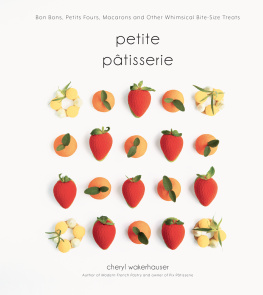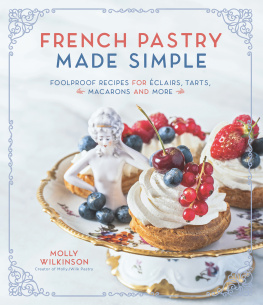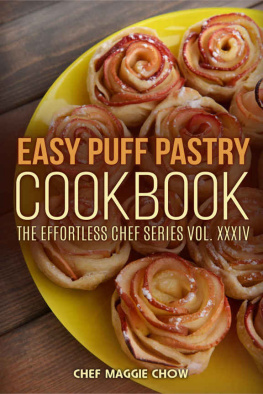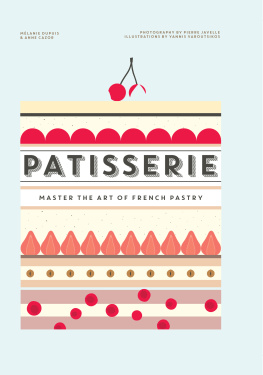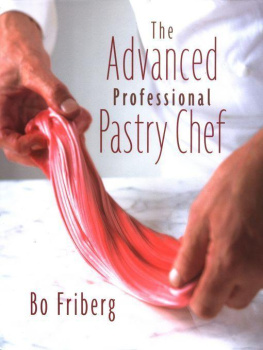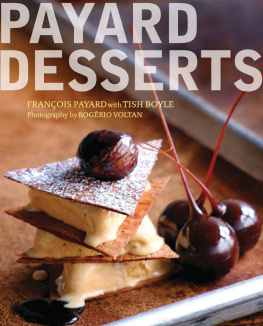MODERN
FRENCH PASTRY
Innovative Techniques, Tools and Design
CHERYL WAKERHAUSER, owner of Pix Ptisserie

Thank you for buying this
Page Street Publishing Co. ebook.
To receive special offers, bonus content,
and info on new releases and other great reads,
sign up for our newsletters.

Or visit us online at
us.macmillan.com/newslettersignup
The author and publisher have provided this e-book to you for your personal use only. You may not make this e-book publicly available in any way. Copyright infringement is against the law. If you believe the copy of this e-book you are reading infringes on the authors copyright, please notify the publisher at: http://us.macmillanusa.com/piracy.
WHAT IS FRENCH PASTRY?
Opra, Tarte au Citron, Mont Blanc quintessential classic French pastries. I remember my first visit to Paris (there have been many since), when I took a photo with every dessert I ate. They were just so beautifulexquisitely decorated, colorful and presented in jewelry boxlike pastry cases. But certainly not too pretty to eat, with every bite bursting with a myriad of textures and seductive flavors. These were not brownies. This was not pie. And certainly, they were no cupcakes.
Most popular American desserts are two dimensionalcake and frosting, pie and crust, dare I say Jell-O and whipped cream. You have two flavors and two textures. They are often overly sweet, which may be why some people insist they dont like dessert. Presentation can be less than stellara cut-up cake fallen over on a plate has no resemblance to its whole counterpart.
The deep-rooted pastry culture in France is much different. To them, its an art. To them, its tradition. To them, there is more to dessert than sugar. The pastry profession is an honored craft. Driven ptissiers spend years of their lives training for a three-day test to become a Meilleur Ouvrier de Francethe best worker of their craft. Even those that dont accomplish the daunting feat take their daily work very seriously. Ive worked alongside rugby players pulling beautiful sugar roses at four in the morning and teenagers working long hours as stagiaires (interns) unmolding bche de nol after bche de nol in preparation for Christmas. It is a labor of love and it shows.
When you walk into a ptisserie in France, the desserts in the pastry cases will captivate you. Rows upon rows of slender clairs, colorful macarons and tarts piled high with wild strawberries, physalis and red currants. Each dessert is like a little package or gift, crafted individually so you dont have to share, and decorated as if it were going in a museum, not in your mouth. When you do take a bite you can expect something crunchy, something creamy, perhaps a crack of caramel or a soft, tender cake soaked in rum. The flavors can be bold, or slightly flirtatious, but there will always be many. Aside from their beauty, it is the layering of many textures and flavors you get in every bite that sets French ptisserie apart from other desserts. It is this multidimensionality that make them complex and so enjoyable, a bit like a fine wine.
SECRETS TO SUCCESS
Lets be honest, creating French-style desserts can be difficult and a bit intimidating. Macarons have only three ingredients, but time and time again, attempts to make them are unsuccessful. The success of pastry making relies on technique, quality ingredients and having the right equipment.
This book will guide you through the basic techniques commonly used in French pastry. Learn the difference between French meringue and Italian meringue. Prepare a proper caramel. Temper chocolate in your microwave. Although some of the recipes may seem a bit daunting in length, the results are well worth it and you will be amazed at what youve accomplished. Once you have mastered the techniques, take components from one dessert and combine them with components from another to create your own masterpiece. The possibilities are unlimited.
Not all chocolates are created equal and sugar can come from beets or cane. The importance of choosing fresh, high-quality ingredients will be reflected in your results. If you start with subpar, its not going to get any better.
Equally important is the equipment you choose. Since pastry is part art, part science, precision is of the utmost importance. That is why all ingredients in this book are measured on a scale. I cannot stress enough the importance of weighing your ingredients versus using cups and spoons. If ten people scoop a cup of all-purpose flour and put it on a scale they will all weigh differently. Yet if that same ten weighed 100 grams of all-purpose flour on a scale, everyone would have exactly the same amount of flour. If the recipe calls for 100 grams of flour, thats what it needs, not 115 grams. If you have a recipe that calls for three large eggs and you have only medium eggs, what do you do? If instead, the recipe calls for 150 grams of eggs, you simply add enough beaten medium eggs until the scale reads 150 grams. Easy and simple. A digital scale will be your new best friend.
ODDS AND ENDS
Every recipe in this book lists ingredients by weight in grams, including liquid ingredients. If you are unfamiliar with metric, dont worry. All you need to do is put your ingredients on the scale. Thats it!
Here are some general measurements to get you accustomed to thinking in metric:
1 large egg = 50 g (20 g for the yolk and 30 g for the white). If you need to measure partial eggs, say 130 g, crack three eggs in a bowl, break them up with a fork and pour 130 g into your recipe.
1 cup of flour = 130 g
1 cup of sugar = 200 g
1 cup of heavy cream = 255 g
1 packet of powdered gelatin = 7 g
NOTE: You can substitute sheet gelatin by weight one to one. Ignore the water listed in the recipe and use enough cold water to submerge the sheets. Excess water not absorbed will be rung out.
All baking instructions are for still, conventional ovens that do not have a fan. If you have a convection oven and want to bake with the fan on, just lower the temperature by 25F (14C). Baking times may be a bit faster, so check the product earlier than noted.
Some recipes require mixing very small quantities. Depending on the size of your stand mixers bowl, the attachment may barely reach the ingredients. Prop the bowl up slightly by placing a towel over one or both of the pegs that hold the bowl, before attaching it to the mixer, making sure it is secured in the back. Thats what we call a Parlor Trick!
Throughout the book you will see PARLOR TRICK! This is where we offer tips and shortcuts, sometimes debunking classic techniques, such as making pastry cream in the microwave. Why dirty several dishes, stand there stirring for five minutes and risk burning your pastry cream? Instead, place everything in one bowl, place it in the microwave and walk away. No risk of burning and no muscles required.
Finally, it is strongly recommended that you read the entire recipe and weigh all your ingredients before starting any dessert. A successful ptissier is always a well-organized one.
For more detailed information about equipment and ingredients used in this book, visit www.modernfrenchpastry.com.



